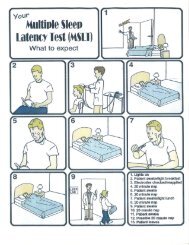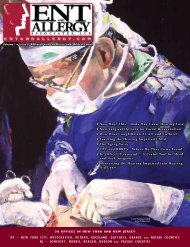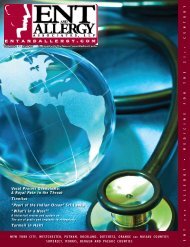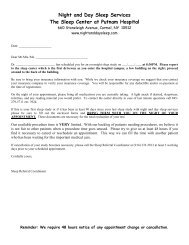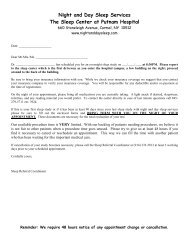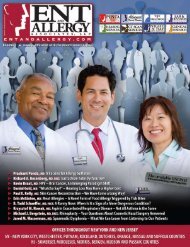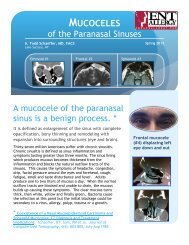PSG Confirmation Packet - ENT & Allergy Associates
PSG Confirmation Packet - ENT & Allergy Associates
PSG Confirmation Packet - ENT & Allergy Associates
You also want an ePaper? Increase the reach of your titles
YUMPU automatically turns print PDFs into web optimized ePapers that Google loves.
SLEEP STATISTICS<br />
More than 18 million Americans suffer<br />
from sleep apnea**<br />
It is conservatively estimated that 10<br />
million Americans remain undiagnosed**<br />
More than half of all cases of sleep<br />
apnea are diagnosed in people 40 years<br />
of age or older**<br />
Sleep apnea is more prevalent in men<br />
than women**<br />
More than 70 million Americans suffer<br />
from disorders of sleep and wakefulness**<br />
Of the 70 million, nearly 60 percent<br />
have a chronic disorder**<br />
Research suggests that adults require<br />
an average of 8 to 8.5 hours of sleep<br />
each night**<br />
Each year, sleep disorders, sleep deprivation<br />
and sleepiness add an estimated<br />
$15.9 billion to the national health care<br />
bill**<br />
The International Classification of<br />
Sleep Disorders lists 84 sleep disorders<br />
of sleep and wakefulness that<br />
serve as a guide for diagnosis<br />
For a complete list of AASM-accredited<br />
sleep centers, visit www.aasmnet.<br />
org or call (888) 41-AWAKE<br />
**Statistic from the National Institutes<br />
of Health National Center for Sleep<br />
Disorder Research<br />
sleep apnea<br />
Sleep apnea is a common sleep disorder characterized by brief cessations in<br />
breathing during sleep. The two most frequent symptoms of sleep apnea are<br />
loud snoring and excessive daytime sleepiness; morning headaches and awakening<br />
with a dry mouth or sore throat are also signs of sleep apnea.<br />
In most cases, sleep apnea occurs when the throat muscles and tongue relax and<br />
partially block the opening of the airway during sleep. Though an individual continues<br />
their efforts to breathe, air cannot easily flow into or out of the nose and this<br />
results in heavy snoring, arousals, and periods of no breathing.<br />
There are two types of sleep apnea: central and obstructive.<br />
• Central sleep apnea<br />
Central sleep apnea is characterized by a cessation or decrease in breathing during<br />
sleep. Individuals sustain several awakenings during the night, sometimes<br />
with a gasp for air. Additionally, individuals experience circulatory complications,<br />
including irregular heartbeats, pulmonary hypertension, and heart failure.<br />
Snoring may occur, though it is not prominent.<br />
• Obstructive sleep apnea<br />
Obstructive sleep apnea, the more common of the two, is characterized by the<br />
muscles in the walls of the throat relaxing while the person sleeps so that the<br />
walls collapse on themselves and obstruct the flow of air. After about 30 seconds,<br />
the obstruction is relieved and breathing resumes. Symptoms of obstructive<br />
sleep apnea intensify with increased body weight and blood pressure.<br />
Individuals who believe they suffer from sleep apnea should first contact their primary<br />
care physician for a diagnosis. With the proper diagnosis, patients can begin<br />
testing and treatment, usually at a sleep center or lab. There are several treatment<br />
options available, and therapy is customized for the individual. Behavorial<br />
changes, including weight loss, changes in sleeping devices, and the avoidance of<br />
alcohol and sleeping pills, are suggested for mild cases. The most common treatment<br />
for more severe sleep apnea cases is continuous positive airway pressure<br />
(CPAP). The CPAP device is a mask that provides pressure from a blower that<br />
forces air and prevents airway closure. Dental devices are a less cumbersome<br />
alternative to CPAP, and are designed to move the jaw forward and subsequently<br />
open air passages. Additionally, surgical procedures that improve sleep apnea and<br />
snoring by enlarging air passages are options for individuals.<br />
The American Academy of Sleep Medicine is a professional organization dedicated to advancing sleep health<br />
care by setting clinical standards for the field; advocating for recognition, diagnosis and treatment of sleep disorders;<br />
educating professionals dedicated to providing optimal sleep health care; and fostering the development<br />
and application of scientific knowledge.<br />
© AASM 2003<br />
One Westbrook Corporate Center, Suite 920<br />
Westchester, IL 60154<br />
(708) 492-0930<br />
www.aasmnet.org



